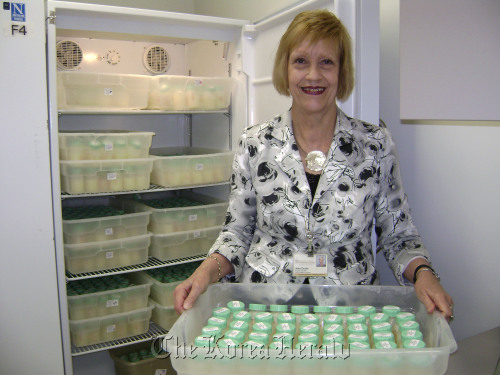ATHENS, Ohio (AP) ― With her baby fast asleep in the stroller, Valerie Githinji made her way up to the nurses’ station in O’Bleness Memorial Hospital’s maternity ward.
She came bearing gifts. Stored in the bottom of the stroller, in a white plastic bag, were several containers totaling 5,670 grams ― more than 5.6 liters ― of frozen breast milk.
Githinji, who works in student affairs at Hocking College, has been donating her extra breast milk for about four months.
“Every time I feed my daughter, I tell her, ‘We’re feeding you and the world,’” she said, with a laugh.
This drop-off brought her total donation to nearly 30 liters, but this trip was made specially in response to a call put out by the Human Milk Banking Association, which sets standards for milk banks in Canada, Mexico and the U.S. The organization has been asking mothers to give whatever they can to help meet an increased demand for donated breast milk.
She came bearing gifts. Stored in the bottom of the stroller, in a white plastic bag, were several containers totaling 5,670 grams ― more than 5.6 liters ― of frozen breast milk.
Githinji, who works in student affairs at Hocking College, has been donating her extra breast milk for about four months.
“Every time I feed my daughter, I tell her, ‘We’re feeding you and the world,’” she said, with a laugh.
This drop-off brought her total donation to nearly 30 liters, but this trip was made specially in response to a call put out by the Human Milk Banking Association, which sets standards for milk banks in Canada, Mexico and the U.S. The organization has been asking mothers to give whatever they can to help meet an increased demand for donated breast milk.

Part of the demand comes from hospitals. More neonatal intensive-care units are keeping inventories of human donor milk, and most breast milk donated to the Human Milk Banking Association goes to premature babies.
Several banks recently had such low supplies they’ve had to turn away people seeking milk for their infants, said Jean Drulis, director of the Mother’s Milk Bank of Iowa and president of the milk banking association. Some banks are sharing their supply temporarily to fulfill requests.
“As the word spreads about the availability, so will awareness about the demand,” Drulis said. “We know there are more donors.”
The organization is also encouraging new mothers to start donating.
Last year, the association’s 10 banks dispensed more than 1.8 million ounces, up from 400,000 ounces 10 years ago.
Another factor in increased demand is more awareness among parents. Some parents are offered the milk when supplementation is needed, while others are starting to request it. A baby might need supplementation because of allergies, formula intolerance or immunological deficiencies. When available, banks will offer donor milk to healthy babies who aren’t able to get their own mother’s milk.
Githinji started pumping extra ounces to prevent engorgement, which is when breasts overfill with milk to the point of discomfort.
Once she realized she could donate her milk, she loved the idea. She even wrote a poem about it, called “To the li’l baby I’m helping to grow well.”
Milk donated to a milk bank is sent to the nearest processing plant. In Githinji’s case, that’s Columbus. There it will be pasteurized, refrozen and sent back to area hospitals, like O’Bleness, or sold to individuals with prescriptions.
Donors are not paid for their milk, and milk banks, which are all non-profits, don’t charge for the milk, but they do pass on processing costs. Making sure the milk is safe for babies to consume involves extensive donor screenings, pasteurization and transportation fees. Iowa, for example, sells donated milk for just over $4 per 28.35 grams.
“There hasn’t been a safety issue in our 25-year history,” Drulis said. “There’s a price for that.”
How much a baby consumes, and therefore how much it costs to supply an infant with donated milk, varies widely. An ounce might yield several feedings for a preemie, which might be manageable for families whose insurance won’t cover the costs. But a 4.5-kilogram baby might drink 850 grams a day.
Some women opt for a free alternative called informal sharing, which means that women who have extra milk simply give it to mothers who need it. Organizations like Eats on Feets and Human Milk 4 Human Babies help these moms connect on Facebook.
But the U.S. Food and Drug Administration recently came out against informal sharing, saying the milk hasn’t been “adequately screened” and is unlikely to have been “collected, processed, tested or stored in a way that reduces possible safety risks.”
Moms like Greta McCool, a registered nurse in Wauwatosa, Wisconsin, who opted to get milk from informal sharing because her own supply of breast milk was inadequate to feed her son, aren’t worried. ”If their babies are thriving, it will be fine for my child,“ she said, though she did take the step of confirming that her donors are HIV-negative.
Part of the U.S. Surgeon General’s recent “Call to Action to Support Breastfeeding” specifically mentions the need to identify and address obstacles to greater availability of safe donated human milk. For now, though, it’s up to individual mothers to fill the need.
Those like Githinji will continue to offer her gift, one extra pump at a time.
“These milk donors are truly remarkable,” Drulis said. “The service they’re doing to mankind is just amazing. It’s totally altruistic.”








![[Kim Seong-kon] Democracy and the future of South Korea](http://res.heraldm.com/phpwas/restmb_idxmake.php?idx=644&simg=/content/image/2024/04/16/20240416050802_0.jpg&u=)







![[KH Explains] Hyundai's full hybrid edge to pay off amid slow transition to pure EVs](http://res.heraldm.com/phpwas/restmb_idxmake.php?idx=652&simg=/content/image/2024/04/18/20240418050645_0.jpg&u=20240418181020)

![[Today’s K-pop] Zico drops snippet of collaboration with Jennie](http://res.heraldm.com/phpwas/restmb_idxmake.php?idx=642&simg=/content/image/2024/04/18/20240418050702_0.jpg&u=)